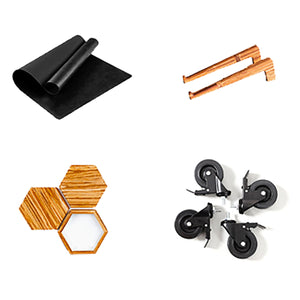
How Does Recycling Reduce Carbon Emissions?
Canada’s carbon emissions have been on the rise since the Industrial Revolution, only to continue their upward trend at an alarming rate. From 1990 to 2019, the total amount of emissions increased by 21.4%, primarily driven by human activity like oil extraction and the transportation sector. The most recent report by the Intergovernmental Panel on Climate Change (IPCC) states that unless countries make drastic changes to the rate of greenhouse gas emissions, we won’t be able to slow down global warming.
These greenhouse gas emissions include carbon dioxide (CO2), methane, nitrous oxides, and chlorofluorocarbons (CFCs), getting their name from the “greenhouse” effect they leave on our planet. These gases create an atmosphere that traps heat radiating from the Earth’s surface. Instead of letting heat back out into space, the Earth turns into a greenhouse--heat can get into the atmosphere, but has a hard time getting out. That, in turn, contributes to global warming and climate change.

Greenhouse Gas Culprits
Greenhouse gas emissions are caused by human activity, primarily from the electrical, agricultural, transportation, and industrial sectors.
According to a study conducted by the government of Canada, in 2019 the oil and gas sectors accounted for 52% of total emissions, with the transportation sector coming in as the second biggest culprit.
This irreversible damage is a direct result of the burning of fossil fuels for transportation, burning coal or natural gas for heating, deforestation, and chemical by-products released from factories during the industrial processes.

Breakdown of Canadian greenhouse gas emissions by sector.
Global Warming
According to the International Panel on Climate Change (IPCC), we are reaching a “code red for humanity” with the global temperature 1.09C higher than pre-industrial levels. The Sixth Assessment Report indicates that human-induced global warming has led to increases in both land and ocean temperatures, frequent heat waves, as well as an increased risk of drought in many parts of the world.
Governments around the world have united under the Paris Agreement, pledging to reduce greenhouse gas emissions and work together to slow global warming and achieve a climate-neutral world by mid-century.
Recycling to Reduce Greenhouse Gas Emissions
By now, you’ve probably heard of the three R’s: Reduce, Reuse, and Recycle. These three steps are simple guidelines to slow the impact we have on the environment.
Start by reducing the amount of energy and products you use. This could be as simple as turning off the lights when you leave a room or bringing a reusable bag to the grocery store. Reuse items and materials in any way you can! Instead of throwing out your plastic iced coffee cup after a single use, save it for next time. If you can’t reuse that item, recycle it.
Even though recycling is the last option in the 3 R’s, diverting items from a landfill helps communities to be environmentally sustainable. With less waste going straight to a landfill, we can work together to prevent our carbon footprint from further growth.
carbon footprint: the sum of all carbon dioxide (CO2) emissions produced by human activity in a given time frame, usually a year. For example, every gallon of gasoline burned produces 8.7 kg of carbon dioxide!
Consuming Responsibly

Reducing waste is a key part of reducing carbon emissions. Single-use and disposable products are designed to be just that--cheap items that are thrown away after just one use. From plastic bags, to disposable cutlery and take out containers, single-use items have become the norm. Unfortunately, most of these single-use plastics aren’t even recyclable!
Cutting down on plastic use is the first step to reducing greenhouse gas emissions. A report by the Centre for International Environment Law showed that every step in the plastic manufacturing process produces harmful greenhouse gases which contribute to climate change.
Instead of plastics made from raw materials, look out for plastics made out of post-consumer material.
post-consumer material: a finished material which would normally be disposed of as a solid waste, having reached its intended end-use and completed its life cycle as a consumer item.
Disposable items made from post-consumer material helps divert plastics from landfills, keeping them in use for a longer period of time. This supports the idea of a circular economy--read more about that here!
Why Recycle?
Effective recycling helps to not only reduce the amount of waste that ends up in landfills and garbage patches in the ocean (currently, the Great Pacific Garbage Patch is twice the size of Texas and three times the size of France).
It helps to create post-consumer materials that have already been “used,” which reduces the need for raw materials. Recycling one ton of paper saves 19 trees from being cut down, and tree preservation then cuts down on carbon dioxide in the atmosphere.
It also helps to cycle materials back into production, which cuts down on greenhouse gases from factories and manufacturing plants. Did you know the production of recycled paper requires 65% less energy than producing paper from raw materials?
Support businesses that keep it green!

Although the damage on our planet is irreversible, there are simple steps we can take to live a more sustainable lifestyle and slow the effects of global warming. Now more than ever, it is crucial that we protect the planet for ourselves and future generations to come.
Making the switch to supporting Canadian businesses that put the planet first is a great way to start.
Vancouver-based company ChopValue has collected and recycled over 35.3 million chopsticks (and counting!) that would otherwise have gone straight into a landfill. This post-consumer material is available in abundance as over 100,000 disposable chopsticks get thrown out in Metro Vancouver every day.
ChopValue’s remanufacturing process is entirely carbon-negative, which means it stores more energy than it uses. After the urban harvest, chopsticks are sanitized in extremely hot ovens, reducing water waste to nearly nothing! The chopsticks are then treated with resin for a sleek, shiny finish.

The result? A material that’s stronger and more durable than most other wood products. EFFYDESK has partnered with ChopValue to bring you a tabletop that’s made of 100% post-consumer material--over 10,000 chopsticks that would otherwise have gone straight to a landfill! The TerraDesk comes with powerful dual motors that move the tabletop with ease—no need to compromise on ergonomics when you buy an earth-friendly desk.
Your TerraDesk is shipped to you in sturdy and 100% recyclable packaging (which can even be upcycled—check out some cardboard upcycling DIYs!). Already have an electric standing desk and looking for earth-friendly desk accessories? Keep your eyes peeled for our Closed Loop collection! Our collaboration with ChopValue continues with a line of environmentally sustainable and minimalist office supplies. Join us on our journey towards a circular economy!























